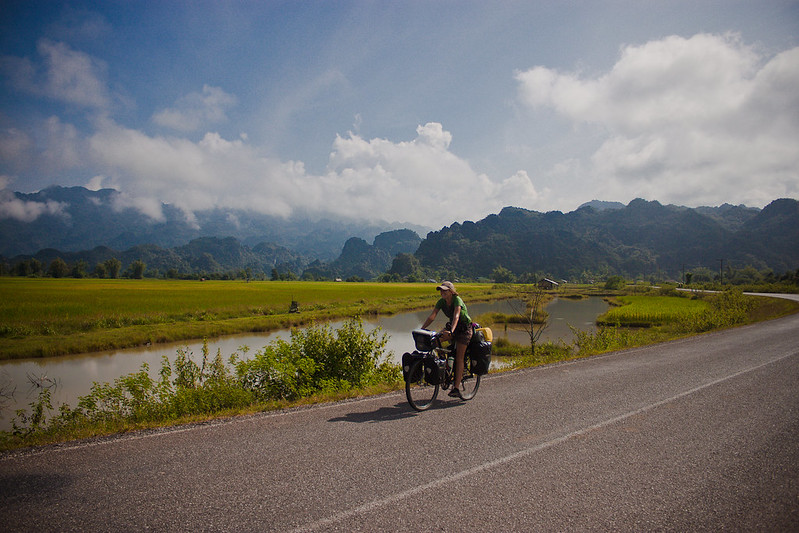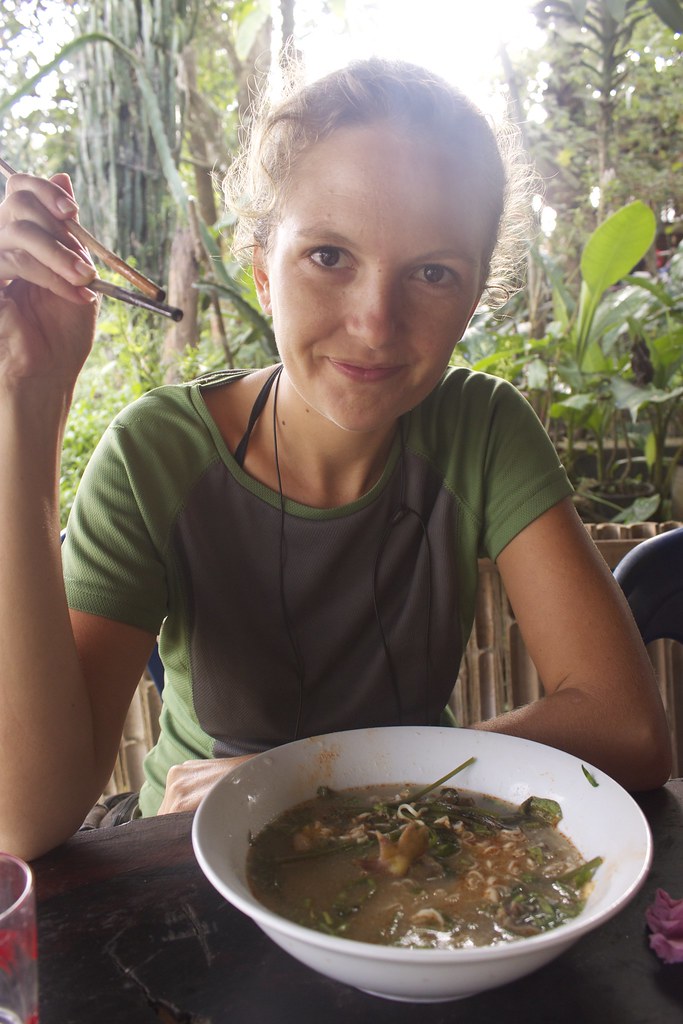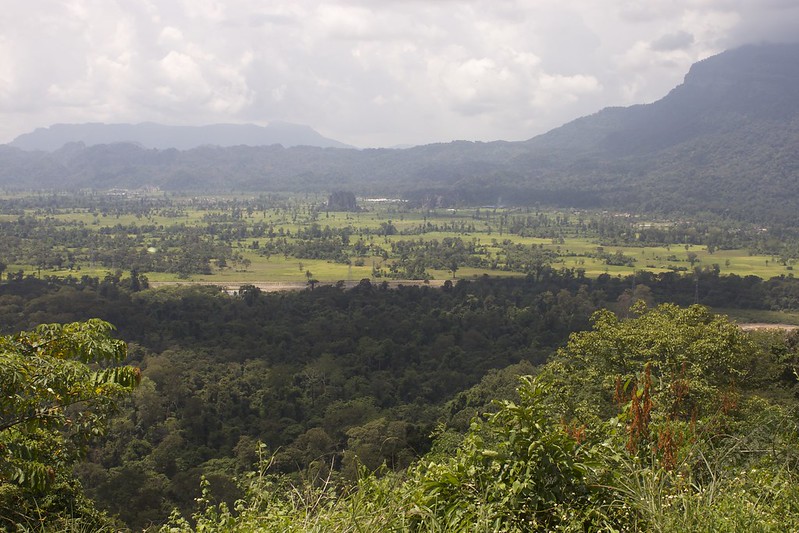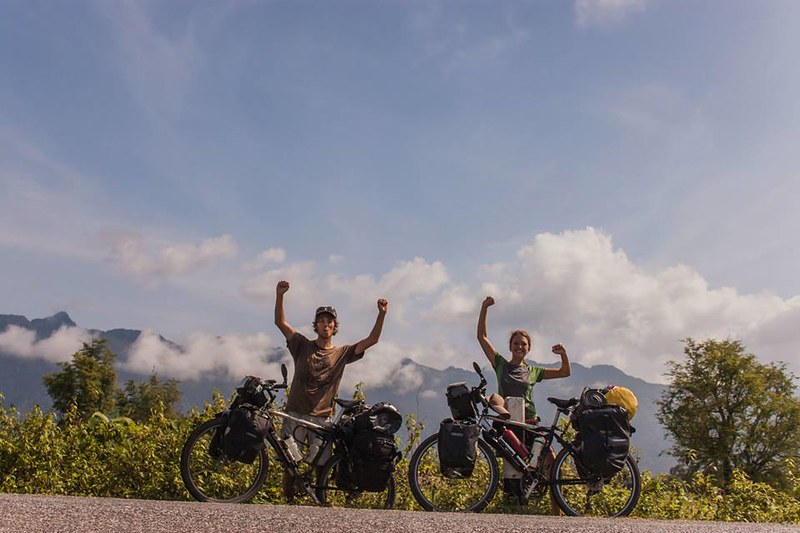We knew something was wrong as soon as the two steaming bowls were placed before us. Tangled among Liv’s noodles and protruding from the water rose a strange orangey-red flap.
“Is that a… fin?” she poked it with her chopstick.
It was morning on our first full day riding in Laos and our stomachs were rumbling. We’d spotted the tell-tale chequered tablecloths outside this little roadside shack a few minutes before and couldn’t believe our luck when the lady here offered us chicken to go with our noodle soup. Noodle soup had been the mainstay in Vietnam and it was terrible; oily water, noodles and a few slices of spring onion: there were barely enough calories in there to last an hour on the road. We knew that Laos was much poorer than Vietnam so securing decent food out here might be a challenge. But here was chicken noodle soup. Yes please!
Now we were frowning into our bowls. Liv gave the protrusion another jab and it rolled to reveal a squinting eye and pink cerebral matter. It was a cockerel’s comb with the upper third of the head still in tow. Indeed, both of our bowls were bobbing with the hacked remains of the bird's head and legs: a massacre for breakfast. We stared glumly into the bowls. The bowls stared back.
But when you’re riding there’s not much room to be fussy, and it didn’t taste so bad. The comb had a texture not unlike thick, slightly undercooked pasta: rubbery with a cartilaginous snap at the centre. The eyes and brain were, however, far too much for either of us to even contemplate at that hour of the morning. I was just glad we didn’t order beef.
We’d set off early that morning into a world lost to fog. The fields around us were dissolved in a smoulder that choked the early sunlight and shrouded the landscape in soft, uncertain forms. Towers of karst loomed up out of the mist like ships, while islands of foliage hovered abstractly in the distance. The road, thankfully, was deserted.
As the hours ticked by the morning wore through. The sun sputtered and caught, smears on the horizon sharpened into hills and, like a valet’s rag lifted from a boot, the morning emerged a brilliant shining blue.
 We sailed that day along a road of near-perfect asphalt that dipped through wide arenas of paddy agriculture ringed by thick, broccoli-head hills. As we reached the edge of these sanctuaries the road would coil up into the shade of the greenery, and after a modest climb we’d spill down into the next plain with a welcome rush of cool air.
We sailed that day along a road of near-perfect asphalt that dipped through wide arenas of paddy agriculture ringed by thick, broccoli-head hills. As we reached the edge of these sanctuaries the road would coil up into the shade of the greenery, and after a modest climb we’d spill down into the next plain with a welcome rush of cool air.
It was still the early half of the afternoon when we hit the final summit of the day. Sprawling out below us was a vast grassland spattered with trees and embroidered with the thread of a sparkling river. We’d just ticked over the 10,000km mark. Cycling felt good again.
We lingered a while before descending into the plain and the bright little market village that lay tucked up against the base of the hill. This was Nahin, a serene little street of corrugated tin roofs, market stalls and tinkling cowbells. We bagged a room in a neat, wood-panelled property and spent the latter half of the afternoon ambling around the grassy paths before being called over to shoot fermented bark liquor off a tree stump with some of the locals. We chatted until the light began to fade, the smell of barbecue smoke wafted in and we took our leave to head to one of the town’s bamboo and thatch restaurants for a hearty meal of meat, rice and vegetables with an ice-cream dessert. I tell you: tired legs, a weeny bit drunk and a full belly—life does not get much better than that.
We hadn’t had a proper rest day since before the attack in Vietnam almost a week ago, but by the next morning it was clear that we couldn’t just spend the entire day relaxing. Our bikes needed some work and we had to figure out our route across the country. Our original plan had been to follow the highway all the way to Vientiane, then cut north through Luang Prabang to the Chinese border, but after our cross-country rumble through Cambodia’s north-east and the daily bombardments of fruit and abuse in Vietnam, the notion of simply pedalling along a highway, even if it was quite hilly, just felt a bit tame.
There were also more pragmatic concerns. In four weeks time we would be crossing into China and we had promised ourselves that we were going to try and make it through some proper mountains and onto the edge of the Tibetan Plateau. In ideal circumstances this was bordering on reckless. There were wolves, bears, hypothermia and altitude sickness to worry about. But on top of these we would be arriving at the worst time, with winter fast approaching and reports going round that one of the crucial roads was currently impassable.
We’d buy a big blanket and hope the road got fixed. That was the plan. But if the road did open up and we didn’t freeze to death, the jagged topographic charts made it abundantly clear was that we’d need to be at the very top of our game if we were going have a chance of pulling this off. We needed to be fit, and we needed to be prepared. We needed to make the most of Laos’ hills and backroads. So that afternoon I was sat hunched over a keyboard in the gloom of the village internet shack, poring over satellite imagery, maps and travel blogs as the generator roared behind me. There did seem to be an alternative route through Laos that broke north just a few days further west along the highway, although I could find no reports of anybody having cycled it—just one guy tackling it in a 4x4 coming in the other direction several years earlier. It sounded pretty rugged. It was perfect.
Our bikes, however, were in serious need of attention. That morning we had wheeled them round the side of the guesthouse and set to work. Besides the usual cleaning, calibrating and oiling, Liv had to fit a fresh set of off-road tyres that her parents had delivered in Hoi An. Rather foolishly, I had not taken this opportunity to order replacements because at the time my tyres had been fine. Now, just weeks later, the rubber was balding and had started to fray; they were getting thin and slippery. I had no hope of replacing them here and probably wouldn’t for some time. So I did what I could. I switched them around to prolong their lives, since rear tyres tend to wear quicker than the front; I took my pocket-knife and sawed cross-hatches into the worn rubber to try and improve their grip, though in retrospect I think that just made things worse; then I cleaned, tightened and de-gunked the chain and sprockets. The wheels turned, the brakes stopped them and most of the gears worked fine. It would do.
Liv’s bike looked fearsome with its fat new tyres, but it was also showing worrying signs of wear. The brake pads had worn down to the metal and started chewing into the rims. Three out of the four wear indicators were gone, carved out by ridges that ran right around both sides of both wheels. With all the hills and screaming descents that Laos promised, the prospect of a catastrophic wheel failure was sobering. We needed a bike shop, but we’d have to make do with DIY and good fortune for a week or two as we cut through the backroads and on to Luang Prabang.
* * * * *
 |
| Chicken noodle soup! |
 |
| Map of Nahin |






No comments:
Post a Comment